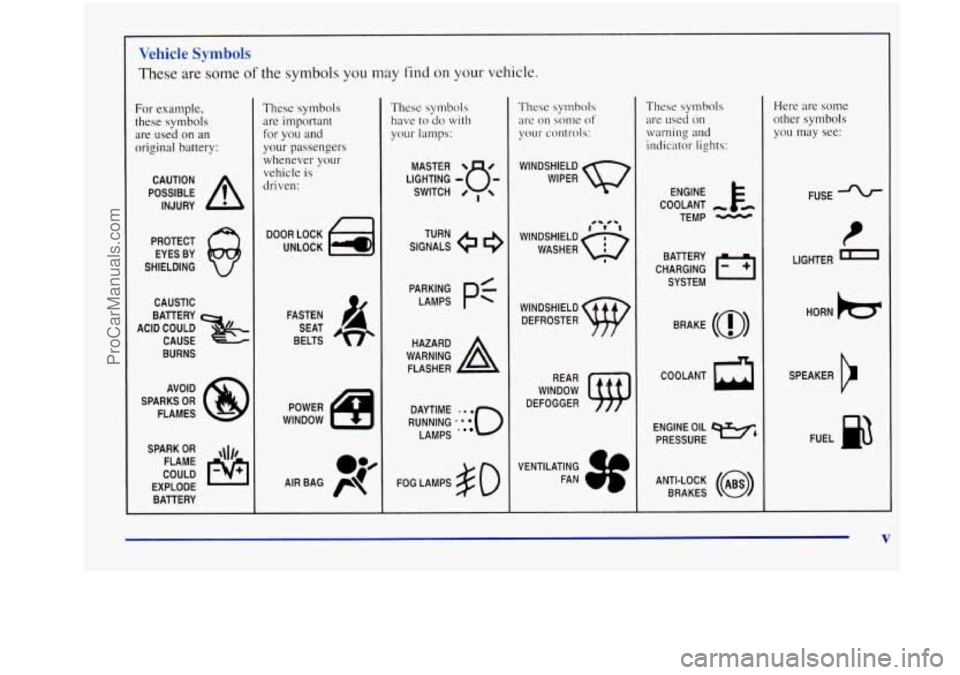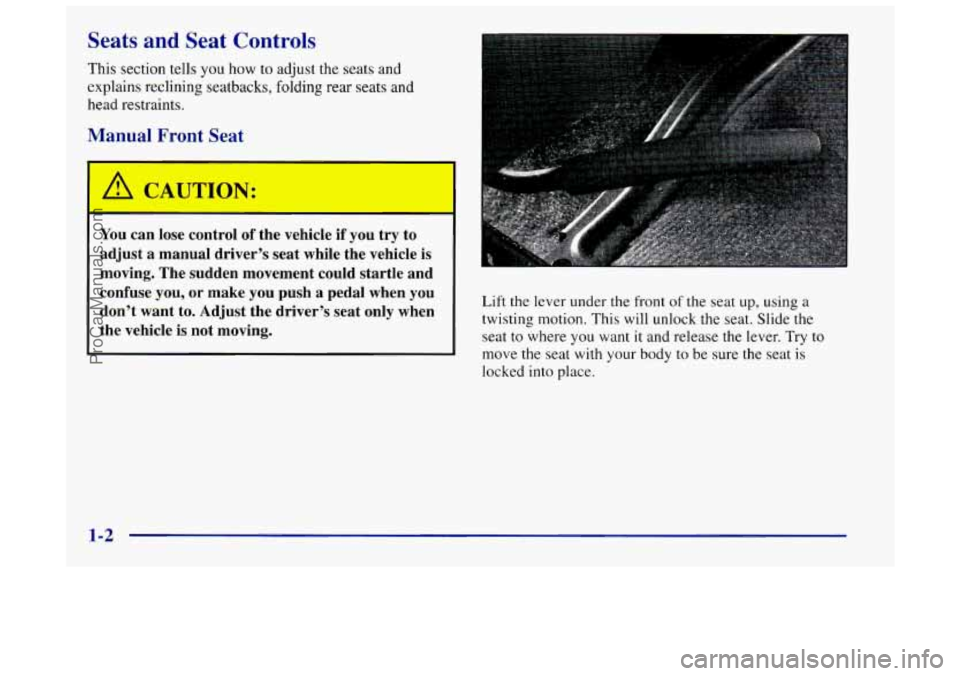lock OLDSMOBILE INTRIGUE 1998 Owners Manual
[x] Cancel search | Manufacturer: OLDSMOBILE, Model Year: 1998, Model line: INTRIGUE, Model: OLDSMOBILE INTRIGUE 1998Pages: 340, PDF Size: 17.93 MB
Page 7 of 340

These are some of the symbols you may find on your vehicle.
For example,
these symbols
are used on an
original battery:
POSSIBLE A
CAUTION
INJURY
PROTECT EYES BY
SHIELDING
CAUSTIC
BURNS
SPARK
OR ,\I/,
COULD FLAME
EXPLODE BATTERY
These symbols are important
for you and
your passengers
whenever your
vehicle is
driven:
DOOR LOCK
UNLOCK
a
FASTEN SEAT
BELTS
These symbols have
to do with
your lamps:
SIGNALS e
TURN
RUNNING
*':**o
DAYTIME LAMPS
FOG LAMPS $0
These symbols
;II% on some of
your controls:
WINDSHIELD
WIPER
WINDSHIELD DEFROSTER
WINDOW
DEFOGGER
VENTILATING FAN
These symbols are used on
warning and
indicator lights:
COOLANT -
TEMP -
CHARGING I-1
BATTERY
SYSTEM
BRAKE
(0)
ENGINE OIL e,
PRESSURE
ANTI-LOCK
(@)
BRAKES
Here are some
other symbols
you may see:
FUSE
LIGHTER
n
HORN )b(
SPEAKER
b
FUEL m
V
ProCarManuals.com
Page 10 of 340

Seats and Seat Controls
This section tells you how to adjust the seats and
explains reclining seatbacks, folding rear seats and
head restraints.
Manual Front Sei- A
A CAUTION:
You can lose control of the vehicle if you try to
adjust
a manual driver’s seat while the vehicle is
moving. The sudden movement could startle and
confuse you, or make you push
a pedal when you
don’t want to. Adjust the driver’s seat only when
the vehicle is not moving.
c I
Lift the lever under the front of the seat up, using a
twisting motion. This will unlock the seat. Slide the
seat to where
you want it and release the lever. Try to
move the seat
with your body to be sure the seat is
locked into place.
1-2
ProCarManuals.com
Page 11 of 340

6-Way Power Seat (If’ Equipped)
This switch is designed
to imitate the movements
of your seat cushion.
It is located on the left
side
of the driver’s or
the right side of the
passenger’s seat cushion.
To move the seat forward or rearward, push the switch
forward or rearward. To raise or lower the seat, push the
switch up or down.
To raise or lower the front portion of
your seat, push the front of the switch up or down. To
raise or lower the rear portion of your seat, push the rear
of the switch up or down.
Reclining Front Seatbacks
Lift the lever to release the seatback, then move the
seatback
to where you want it. Release the lever to
lock the seatback in place. Pull
up on the lever
without pushing
on the seatback and the seatback
will move forward.
1-3
ProCarManuals.com
Page 19 of 340

How to Wear Safety Belts Properly
Adults
This part is only for people of adult size.
Be aware that there
are special things to know about
safety belts and children. And there are different
rules for smaller children and babies.
If a child will
be riding in your vehicle, see the part of this
manual called “Children.” Follow those rules for
everyone’s protection.
First, you’ll want to know which restraint systems
your vehicle has.
We’ll start with the driver position.
Driver Position
This part describes the driver’s restraint system.
Lap-Shoulder Belt
The driver has a lap-shoulder belt. Here’s how to
wear it properly.
1. Close and lock the door.
2. Adjust the seat (to see how, see “Seats” in the Index)
so you can sit up straight.
3.
4.
Pick up the latch plate and pull the belt across you.
Don’t let it get twisted.
The shoulder belt may lock if you pull the belt across
you very quickly.
If this happens, let the belt go back
slightly to unlock
it. Then pull the belt across you
more slowly.
Push the latch plate into the buckle until it clicks.
Pull up on the latch plate to make sure it is secure.
If the belt isn’t long enough, see “Safety Belt
Extender” at the end
of this section.
1-11
ProCarManuals.com
Page 20 of 340

Make sure the release button on the buckle is
positioned so you would be able to unbuckle the
safety belt quickly if you ever had to.
5. To make the lap part tight, pull down on the buckle
end of the belt as you pull up on the shoulder belt. The lap
part of the belt should be worn low and snug on
the hips, just touching the thighs. In a crash,
this applies
force to the strong pelvic bones. And you'd be less Likely
to slide under the lap belt.
If you slid under it, the belt
would apply force at your abdomen.
This could cause
serious or even fatal injuries. The shoulder belt should
go
over the shoulder and across the chest. These parts of the
body
are best able to take belt restraining forces.
The safety belt locks
if there's a sudden stop or crash, or
if you pull the belt very quickly out of the retractor.
1-12
ProCarManuals.com
Page 21 of 340

Shoulder Belt Height Adjuster
Before you begin to drive, move the shoulder belt
adjuster to the height that is right for you.
To move it down, squeeze the release lever and move
the height adjuster to the desired position. You can move
the adjuster up just by pushing up on the shoulder belt
guide. After you move the adjuster to where you want it,
try to move it down without squeezing the release lever
to make sure it has locked into position.
Adjust the height
so that the shoulder portion of the
belt
is centered on your shoulder. The belt should be
away from your face and neck, but not falling
off
your shoulder.
1-13
ProCarManuals.com
Page 27 of 340

The best way to protect the fetus is to protect the
mother. When a safety belt is worn properly, it’s more
likely that the fetus won’t be hurt in
a crash. For
pregnant women, as for anyone, the key to making
safety belts effective is wearing them properly.
Right Front Passenger Position
To learn how to wear the right front passenger’s safety
belt properly, see “Driver Position’’ earlier in this section.
The right front passenger’s safety belt works the same
way as the driver’s safety belt
-- except for one thing. If
you ever pull the shoulder portion of the belt out all the
way, you will engage the child restraint locking feature.
If this happens, just let the belt go back all the way and
start again.
Supplemental Restraint System (SRS)
This part explains the Supplemental Restraint System
(SRS) or air bag system.
Your vehicle has two air bags
-- one air bag for the
driver
and another air bag for the right front passenger.
The air bags in your vehicle may be “Next Generation”
reduced-force frontal air bags.
If your vehicle has a label on the driver’s side door
window, then your vehicle has reduced-force frontal air
bags.
If your vehicle doesn’t have a label, then the air
bags
in your vehicle aren’t reduced-force.
Reduced-force frontal air bags are designed to help
reduce the risk of injury from the force
of an inflating
air bag. But even these air bags must inflate very
quickly if they are to
do their job and comply with
federal regulations.
1-19
-
ProCarManuals.com
Page 35 of 340

Rear Seat Passengers
It's very important for rear seat passengers to buckle up!
Accident statistics show that unbelted people in the rear
seat are hurt more often in crashes than those who
are
wearing safety belts.
Rear passengers who aren't safety belted can be thrown
out
of the vehicle in a crash. And they can strike others
in the vehicle who are wearing safety belts.
Rear Seat Outside Passenger Positions
Lap-Shoulder Belt
The positions next to the windows have lap-shoulder
belts. Here's how to wear one properly.
1. Pick up the latch plate and pull the belt across you.
Don't let it get twisted.
The shoulder belt may lock if you pull the belt across
you very quickly.
If this happens, let the belt go back
slightly to unlock
it. Then pull the belt across you
more slowly.
1-27
ProCarManuals.com
Page 36 of 340

2. Push the latch plate into the buckle until it clicks.
Pull up on the latch plate to make sure it
is secure.
When the shoulder belt is pulled out all the way, it
will lock.
If it does, let it go back all the way and
start again.
If the belt is not long enough, see “Safety
Belt Extender” at the end
of this section. Make sure
the release button on the buckle is positioned
so you
would be able
to unbuckle the safety belt quickly if
you ever had to.
3. To make the lap part tight, pull down on the buckle
end
of the belt as you pull up on the shoulder part.
1-28
ProCarManuals.com
Page 37 of 340

The lap part of the belt should be worn low and snug on
the hips, just touching the thighs. In a crash, this applies
force to the strong pelvic bones.
And you’d be less likely
to slide under the lap belt.
If you slid under it, the belt would apply force at your abdomen.
This could cause
serious
or even fatal injuries. The shoulder belt should go
over the shoulder and across the chest. These parts of the
body
are best able to take belt restraining forces.
The safety belt locks
if there’s a sudden stop or a crash,
or
if you pull the belt very quickly out of the retractor.
You can be seriously hurt if your shoulder belt is
too loose. In a crash, you would move forward
too much, which could increase injury. The shoulder belt should fit against your body.
1-29
ProCarManuals.com